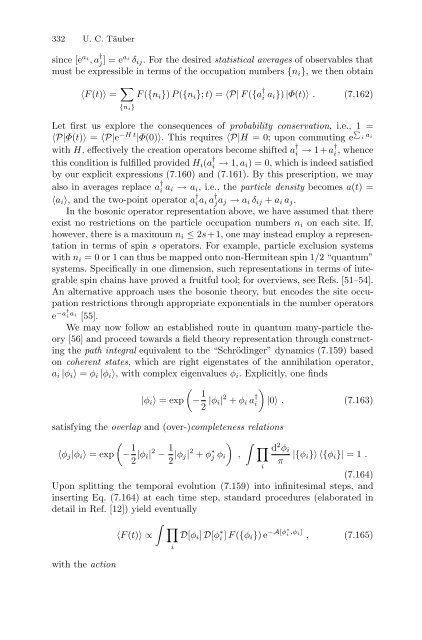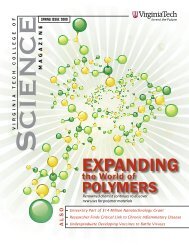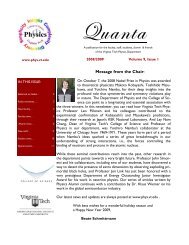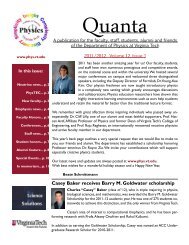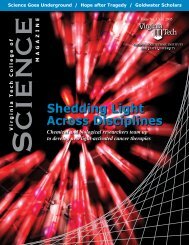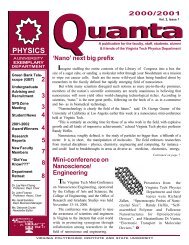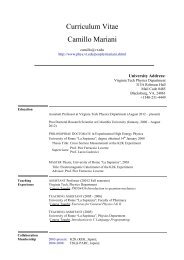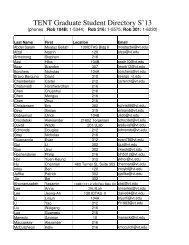Springer Lecture Notes in Physics 716
Springer Lecture Notes in Physics 716
Springer Lecture Notes in Physics 716
Create successful ePaper yourself
Turn your PDF publications into a flip-book with our unique Google optimized e-Paper software.
332 U. C. Täuber<br />
s<strong>in</strong>ce [e ai ,a † j ]=eai δ ij . For the desired statistical averages of observables that<br />
must be expressible <strong>in</strong> terms of the occupation numbers {n i }, we then obta<strong>in</strong><br />
〈F (t)〉 = ∑ {n i}<br />
F ({n i }) P ({n i }; t) =〈P| F ({a † i a i}) |Φ(t)〉 . (7.162)<br />
Let first us explore the consequences of probability conservation, i.e., 1 =<br />
〈P|Φ(t)〉 = 〈P|e −Ht |Φ(0)〉. This requires 〈P|H = 0; upon commut<strong>in</strong>g e ∑ i ai<br />
with H, effectively the creation operators become shifted a † i → 1+a† i , whence<br />
this condition is fulfilled provided H i (a † i → 1,a i) = 0, which is <strong>in</strong>deed satisfied<br />
by our explicit expressions (7.160) and (7.161). By this prescription, we may<br />
also <strong>in</strong> averages replace a † i a i → a i , i.e., the particle density becomes a(t) =<br />
〈a i 〉, and the two-po<strong>in</strong>t operator a † i a i a † j a j → a i δ ij + a i a j .<br />
In the bosonic operator representation above, we have assumed that there<br />
exist no restrictions on the particle occupation numbers n i on each site. If,<br />
however, there is a maximum n i ≤ 2s+1, one may <strong>in</strong>stead employ a representation<br />
<strong>in</strong> terms of sp<strong>in</strong> s operators. For example, particle exclusion systems<br />
with n i = 0 or 1 can thus be mapped onto non-Hermitean sp<strong>in</strong> 1/2 “quantum”<br />
systems. Specifically <strong>in</strong> one dimension, such representations <strong>in</strong> terms of <strong>in</strong>tegrable<br />
sp<strong>in</strong> cha<strong>in</strong>s have proved a fruitful tool; for overviews, see Refs. [51–54].<br />
An alternative approach uses the bosonic theory, but encodes the site occupation<br />
restrictions through appropriate exponentials <strong>in</strong> the number operators<br />
e −a† i ai [55].<br />
We may now follow an established route <strong>in</strong> quantum many-particle theory<br />
[56] and proceed towards a field theory representation through construct<strong>in</strong>g<br />
the path <strong>in</strong>tegral equivalent to the “Schröd<strong>in</strong>ger” dynamics (7.159) based<br />
on coherent states, which are right eigenstates of the annihilation operator,<br />
a i |φ i 〉 = φ i |φ i 〉, with complex eigenvalues φ i . Explicitly, one f<strong>in</strong>ds<br />
(<br />
|φ i 〉 =exp − 1 )<br />
2 |φ i| 2 + φ i a † i |0〉 , (7.163)<br />
satisfy<strong>in</strong>g the overlap and (over-)completeness relations<br />
〈φ j |φ i 〉 =exp<br />
(− 1 2 |φ i| 2 − 1 ) ∫ ∏<br />
2 |φ j| 2 + φ ∗ d 2 φ i<br />
j φ i ,<br />
π |{φ i}〉 〈{φ i }| =1.<br />
i<br />
(7.164)<br />
Upon splitt<strong>in</strong>g the temporal evolution (7.159) <strong>in</strong>to <strong>in</strong>f<strong>in</strong>itesimal steps, and<br />
<strong>in</strong>sert<strong>in</strong>g Eq. (7.164) at each time step, standard procedures (elaborated <strong>in</strong><br />
detail <strong>in</strong> Ref. [12]) yield eventually<br />
∫ ∏<br />
〈F (t)〉 ∝<br />
i<br />
D[φ i ] D[φ ∗ i ] F ({φ i })e −A[φ∗ i ,φi] , (7.165)<br />
with the action


